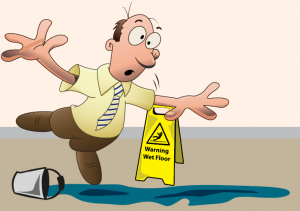How to Identify, Eliminate Slip, Trip and Fall Hazards
July 11, 2017

WHILE BIG-TICKET, dramatic claims make headlines, the reality is that run-of-the-mill workers’ comp injuries end up costing employers the most.
That is especially true for slips, trips and falls. These claims account for nearly one-quarter of all workers’ comp claims and some 300,000 workplace injuries every year, according to the National Council on Compensation Insurance. Slips, trips and falls also account for nearly 1,000 workplace deaths annually.
The average cost of a slip, trip and fall claim was $21,800 in 2009, according to the most recent statistics from the National Safety Council.
There are a number of hidden costs as well, including lost productivity, the cost of additional overtime for workers that cover for their injured colleague, and hiring and training a replacement for when the worker is mending.
Also, the cost of one claim can send your company’s X-Mod higher. With these grim statistics in mind, it should be a priority for your company to do all it can to minimize these expensive and easily avoidable claims.
High-risk Areas
- Floors that can become wet or oily.
- Where external grounds are slippery or uneven.
- Sloping surfaces.
- Work areas where lifting and carrying (and some other manual handling tasks, such as pushing and pulling) are performed.
- Areas where the work pace causes people to walk quickly or run.
- High pedestrian traffic areas.
- Unfamiliar locations, such as client workplaces.
Prevention Tips
- Promptly clean up water or grease on floors.
- Install, maintain slip-resistant flooring in wet areas.
- Require staff to wear slip-resistant shoes in slip-prone areas, such as kitchens.
- Keep floors clean and uncluttered through housekeeping.
- Fix damaged or uneven floors and steps.
- Conduct regular checks of any steps, stools and ladders, and replace if broken.
- Make sure your cords and cables are not in walkways. Instead provide power, phone, and computer services from ducts in the floor or from the ceiling into individual workstations.
- Ensure adequate lighting in work areas, stairs, sidewalks and parking areas.
- Use walk-off mats at entrances and keep a supply of walkway cleaning items.
Properly install and maintain stair handrails and guardrails.